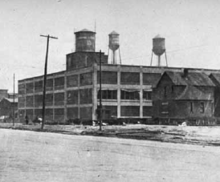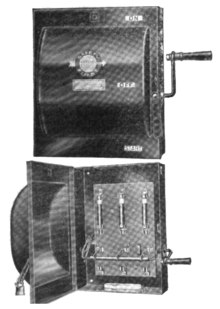Square D
Square D is an American manufacturer of electrical equipment headquartered in Andover, Massachusetts. Square D is a flagship brand of Schneider Electric, which acquired Square D in 1991.
 Square D logo. | |
| Industry | Electrical equipment |
|---|---|
| Predecessor |
|
| Founder | Bryson Dexter Horton |
| Headquarters | , United States |
Area served |
|
| Products | electrical equipment |
| Brands | Square D, QO, Homeline |
Number of employees | 20,000 (es. 2016) |
| Parent | Schneider Electric |
| Website | www |
The company was listed on the New York Stock Exchange for 55 years prior to its acquisition without reporting financial loss in any calendar quarter, paying out 220 consecutive quarterly dividends to shareholders.
History

1900s


The company was founded on December 15, 1902 by Bryson Dexter Horton and James B. McCarthy. In 1903 they incorporated as the McBride Manufacturing Company. During the first decade of business, the company expanded into various other electrical products. In 1908, the company was renamed Detroit Fuse and Manufacturing. Horton, an 1895 electrical engineering graduate of the University of Michigan, was credited with the invention of the safety switch, which encased high voltage switches and started the company's main line of business of circuit breakers and encased control panels.[1] Their first enclosed safety switch was introduced in 1909.
Soon after their renaming to Detroit Fuse and Manufacturing, the company adopted their famous logo — a capital "letter D" for Detroit, enclosed in a square. The logo was stamped on all Square D's switches and products. The combination of an easily remembered monogram logo and their great popularity resulted in customers referring their products as "Square D". Consequently, the company trademarked the logo and in 1917 they renamed the company Square D. Horton served as Square D's president until 1928
1920s-1930s
In the early 1920s Square D sold the majority of their fuse business in order to focus more on their safety switches and other safety products. The company began an aggressive marketing campaign to promote their safety switches. Their advertisements, which became to be known as "Jones is Dead!", directed public attention to the safety hazards of exposed electrical switches in factories. Square D hoped to capitalize on the growing concern of factory safety. One such fully working Square D safety switch from 1922 was donated in November 2003 to the Smithsonian's National Museum of American History.[2]
By 1929, Square D merged with a Milwaukee-based industrial controller company and began producing Westinghouse-licensed circuit breakers. In 1935 Square D began producing its own range of circuit breakers for both commercial and residential uses.[3]
1940s-1970s
1970s-present
In 1991, the company was acquired and became a subsidiary of Schneider Electric.[4] In 2003, the Square D by Schneider Electric brand celebrated its 100th anniversary.
Product lines
Introduced in 1955,[3] the Square D "QO" line of miniature 3/4-inch circuit breakers may be their best-known product line, used in the electrical distribution boards of many residences in North America. The "QO" designation stands for "Qwik-Open"; Square D claims these are the fastest-opening breakers in the industry, responding within 1/60th of a second, or just one full power cycle on a 60 Hz AC line. QO breakers feature a window with a visual trip indication flag, making it easy to identify a tripped breaker in a panel. A "QOB" version is also offered, which stands for "Qwik-Open Bolted", featuring a screw that secures the breaker in the panel. This is useful in industrial installations where vibration might cause a QO snap-in breaker to loosen and prevents them from accidentally being popped out while an adjacent breaker is being changed. A QO breaker could easily be clipped into a QOB panel. The QO and QOB series breakers are by far their most popular commercial products.[5]
A second miniature circuit breaker line is sold under the brand name Homeline, marked "HOM". Designed for value, they lack the fast-trip feature and the visual trip flag of the "QO" series, cost one-third to half less, and are physically not interchangeable with "QO" breakers.[6]
In the 1960s Square D introduced the Safety Line distribution centers for large industrial electrical power loads. This design had solid or tubular busing with each large fused switch clamping onto the busing. The company also sold the B line 277-480 volt panels, generally used for lighting in the 1970s and 1980s.
Another well-known Square D product line is the Powerlink circuit breaker, created for lighting control in commercial buildings. B Line and D Line were the breaker panels in which Powerline breakers were used. Eventually, the company branded Powerline and Powerlink panels and breakers. Powerlink was a heavy duty 277-volt lighting breaker, used in large buildings with 277-volt lighting loads. These were also favored for their robust design, and functional reliability. This means less panel space and wire are needed.
The I-Line series of distribution panelboards is favored by many electricians for its ease and safety of adding new breakers. The panel uses a stacked bus system that protects the energized bus from accidental contact and the breaker can be easily installed using a flat blade screwdriver contacting only de-energized parts of the backplane of the panel. The design of the breakers and panel require that extra attention be paid to phase rotation, as the right (even-numbered) side of the panel will have the phases in a C-B-A configuration whereas the left (odd-numbered) side of the panel will have a more standard A-B-C arrangement.
Square D also made disconnect switches, both fused, and unfused, as well as Heating Air Conditioning and Refrigeration (HACR) rated switch boxes that held an HACR breaker for use as a disconnect. The QO type breaker fits this disconnect box. These were popular with food service, grocers, and other cold storage users.
Other companies used terms like "Quick Lag" and similar brand name letter coding on their circuit breakers, e.g., QL, QLRB, etc. No one knows who started the brand coding for sure. These brand-specific letter codes had nothing to do with National Electrical Manufacturers Association (NEMA) specifications or coding, although they appear to have been intended to emulate NEMA codes.
References
- Clarence M. Burton, William Stocking, Gordon K. Miller (1922). The City of Detroit, Michigan, 1701-1922, Volume 5. S. J. Clarke Publishing Company. p. 187. Retrieved April 20, 2014.CS1 maint: multiple names: authors list (link)
- "1920S Safety Switch Donated to Smithsonian". EWWEB. December 1, 2003. Retrieved April 20, 2014.
- "The Square D key dates" (PDF). Schneider Electric. Retrieved April 21, 2014.
- http://www.schneider-electric.us/about-us/company-profile/history/
- "Square D™ QO™ and QOB Miniature Circuit Breakers". Retrieved August 22, 2016.
- "Square D™ Homeline™ Miniature Circuit Breaker". Retrieved August 22, 2016.
External links
| Wikimedia Commons has media related to Square D. |